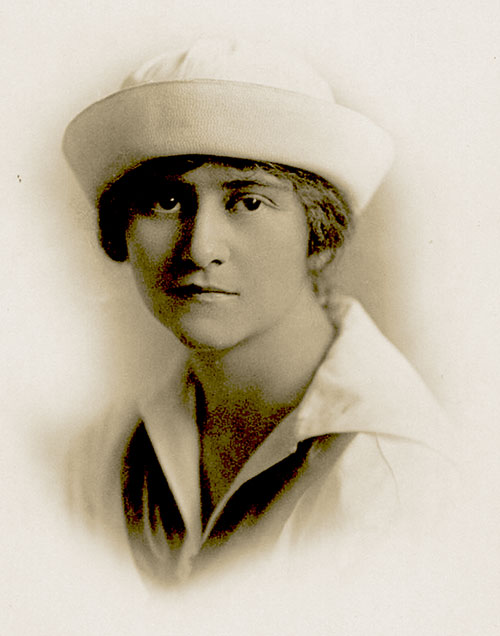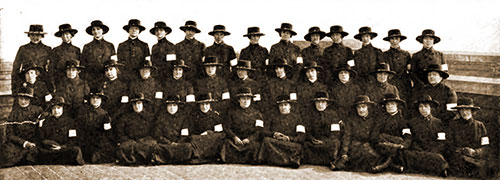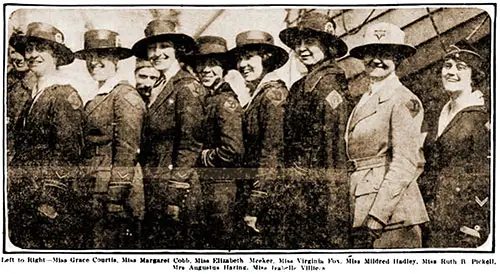The Experience of Isabelle Villiers, Yeoman (f) Turned Hello Girl Supervisor - 2015
The United States entered World War I in April 1917. Along with the men who were recruited to fight, women were eager to assist with war efforts. Such was the case with Isabelle Villiers. Born in Boston, Massachusetts, in 1894, she acted on her patriotic pride and enlisted in the U.S. Naval Reserve Force in May 1917.
For eight months, Isabelle Villiers (Yeoman, 1st class) worked as a confidential secretary in the office of Commodore A.L. Key at the Boston Navy Yard. However, after reading an announcement in the newspaper calling for telephone operators, she decided she could better serve her country overseas.

Photograph of Isabelle Villiers from Her Civilian File at the National Archives at St. Louis. GGA Image ID # 19bafbda53
The war, which had already raged since 1914, had taken its toll on European infrastructure. General John J. Pershing, Commander-in-Chief of the American Expeditionary Forces, had devised a solution for the poor communication on the war front.
War had destroyed the existing French telephone system and he felt that telegrams were too slow and expressionless. Furthermore, General Pershing wanted to establish direct communication between troops on the front line and the general-in-command as well as between allied units.
While servicemen were tasked with laying lines in the field, General Pershing felt that women would best serve as telephone operators. In order to recruit quality telephone operators, General Pershing issued an appeal for 150 women who had past telephone operating experience and who were fluent in both English and French. This appeal was published in newspapers throughout the United States in late 1917.
With an understanding of both languages, former experience as a telephone operator, and a college education, Isabelle Villiers felt compelled to apply.
After receiving a discharge from the U.S. Naval Reserve Force on January 7, 1918, and two months of training in Lowell, Massachusetts, Isabelle set sail for France in March 1918 as a part of the initial group of U.S. Army Signal Corps Female Telephone Operators.
“Hello Girls Here in Real Army Duds” was published on March 19, 1918, in Stars and Stripes cheerfully announcing this first group of 33 arrivals.
Of approximately 1,750 applicants, 450 women were trained and 233 ultimately sent overseas to serve as telephone operators.
Colloquially dubbed “Hello Girls,” these women were primarily stationed in England and France (and in Germany after the Armistice was signed); some were stationed to work on the front lines in locations such as Saint Mihiel and Souilly, France.
Not only did telephone operators work close to the front lines, they wore blue U.S. Army uniforms and were subject to military rules, including the possible penalty of courts-martial for wrongdoing.

Second Group of Telephone Operators Ready for France, to Serve with the American Expeditionary Forces. The Telephone Review, April 1918. Isabelle Villiers, Supervisor was not identified in this photograph. GGA Image ID # 1927e19cd4
Isabelle was assigned as a supervisor to posts in Paris and Tours, France. She completed her duty on April 21, 1919, and returned to Reading, Massachusetts.
She immediately submitted her claim for the $60.00 bonus granted to members of the American Expeditionary Forces only to be denied because the work of telephone operators was not considered to be within the provisions of the Revenue Bill of 1918.
Although women served in a military capacity for the U.S. Navy, Marine Corps, and Coast Guard, after the war was over it was decided that technically only men could be members of the U.S. Army.
Following their service, Isabelle Villiers and many other telephone operators received a certificate for ‘Exceptional Meritorious and Conspicuous Services’ signed by General Pershing along with a letter stating that the “Signal Corps deeply appreciates and is justly proud of the manner in which its civilian employees have performed their duties.”

Women of Y-D Auxiliaries Who Come Back With One to Three Service Stripes. Left to Right: Miss Grace Courtis, Miss Margaret Cobb, Miss Elizabeth Meeker, Miss Virginia Fox, Miss Mildred Hadley, Miss Ruth B. Pickell, Mrs. Augustus Haring, and Miss Isabelle Villiers. The Boston Globe, Friday, 18 April 1919. GGA Image ID # 19bafdd6af
In 1930, a fellow telephone operator named Merle Egan Anderson started the fight for U.S. Army Signal Corps telephone operators’ military benefits. Finally, more than 60 years after the operators served, benefits were approved in 1977 and awarded in 1979 to approximately 50 survivors, including Isabelle Villiers. These brave women were designated the first female veterans of the United States Army.
The official personnel folder of Isabelle Villers and other World War I telephone operators is open to the public.
Ashley Mattingly, "The Hello Girls Finally Get Paid," Archivist at the National Archives at St. Louis, where she manages the collection of archival civilian personnel records, 1915.
